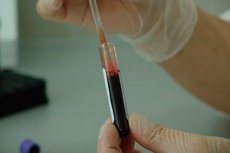Medical expert of the article
New publications
Blood test
Last reviewed: 05.07.2025

All iLive content is medically reviewed or fact checked to ensure as much factual accuracy as possible.
We have strict sourcing guidelines and only link to reputable media sites, academic research institutions and, whenever possible, medically peer reviewed studies. Note that the numbers in parentheses ([1], [2], etc.) are clickable links to these studies.
If you feel that any of our content is inaccurate, out-of-date, or otherwise questionable, please select it and press Ctrl + Enter.

A number of human diseases are accompanied by various disorders of the blood system, the clinical manifestations of which often completely coincide with the symptoms of blood diseases themselves, specially studied by hematologists. These signs reflect disorders of erythropoiesis (accompanied by a decrease in the number of erythrocytes and hemoglobin in the blood), leukopoiesis, thrombocytopoiesis. They are often combined and also accompanied by symptoms of hemorrhagic diathesis, which can be associated with both disorders of thrombocytopoiesis and with a change in the content of factors in the blood involved in coagulation, and changes in the vascular wall itself. Although individual clinical symptoms of hematological diseases can be quite pronounced, laboratory, in particular morphological, research is of important and often decisive diagnostic value.
These methods of blood testing are usually given a leading place in the diagnosis of hematological diseases. Thus, in clinical practice, the so-called general blood test is mandatory, which sometimes allows detecting pathology in people who consider themselves healthy. In this case, first of all, the hemoglobin content in the blood, the number of erythrocytes and leukocytes (with a leukocyte formula ) are determined; this analysis includes the determination of ESR. An important place in hematology is also occupied by the study of bone marrow tissue, which is obtained by puncturing it with a special needle.
Hematology is closely related to oncology - a branch of medicine that studies tumor processes of various localizations. An important condition for the formation of the profession of hematologist-oncologist were the successes in the development of fundamental sciences and chemotherapy, which led to a significant increase in the life expectancy of patients as a result of, first of all, the successful treatment of acute leukemia - the most malignant diseases of the blood system.
The development of leukemia, as well as other types of tumors, i.e. carcinogenesis, is increasingly associated with the action of many physical and biological factors, the source of which is the external environment surrounding a person (ionizing and ultraviolet radiation, some viruses, such as the T-cell leukemia virus, Epstein-Barr, hepatitis B and C). At present, a group of cellular genes designated as oncogenes has been identified; chronic myelogenous leukemia is associated with the Philadelphia (Ph) chromosome.


 [
[